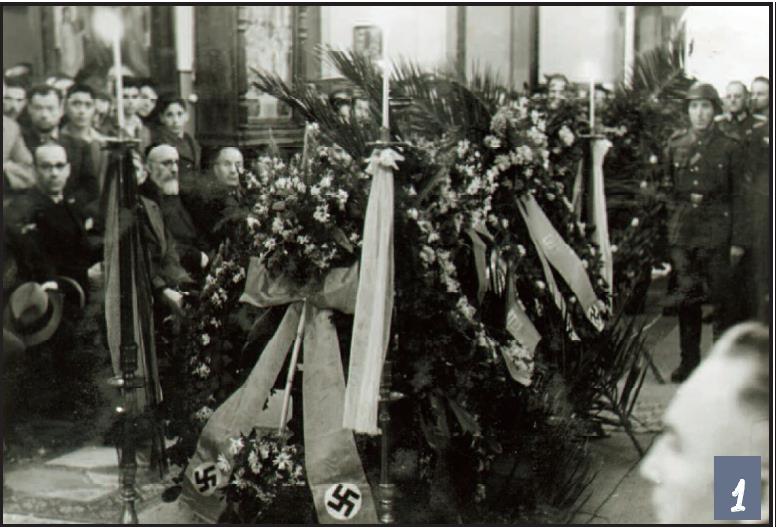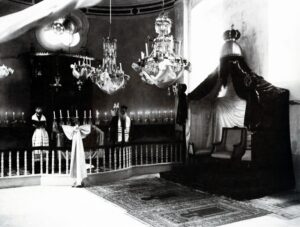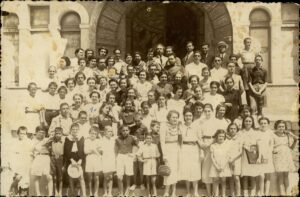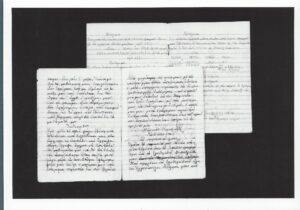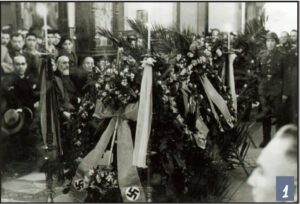Looking for the city’s Jewish community in the everyday life of Chania
City
Migration Period
Category
Full Description
At the end of the interwar period, the Municipality of Chania had a permanent population of about 28,000. Of them, only 400 belonged to the city’s Jewish community. Given the community’s small size, traces of the Jewish presence and activity in the years before they were displaced are not easy to locate in the available sources from the first half of the century.
Few photographs remain from the social activities of the Jews of Chania. The first photograph, a unique piece of historical evidence located some years ago in the archive of the Philological Association of Chania ‘Chrysostomos’, depicts the interior of the Beth Shalom synagogue, a large temple which was bombed in 1941 and was never restored. The occasion on which the photograph was taken is also important. It was December 1913 and the synagogue was festively decorated to welcome King Constantine who was on the island to celebrate the Union of Crete with Greece. In the photograph we can see the last arch-rabbi of Crete, Abraham Evlagon, and Ilias Osmos, who would later become the rabbi of Chania.
The chandeliers are bedecked with white ribbons and the floor is covered with Muslim prayer rugs, possibly used to decorate the synagogue. The throne is topped with a crown and a cross with the letter ‘K’ on either side, indicating that it was meant for the king. That was how the Jewish community participated in the celebrations for the union of Crete with Greece.
The second photograph was taken on the steps outside the Music School of Chania between 1929 and 1935, when Konstantinos Sfakianakis, seen here standing at the top of the stairs, was the director of the school. The note on the back of the photograph informs that the girls annotated with numbers died in the shipwreck that killed the entire Jewish community in 1944. ‘Undergraduates or award-winning piano players: 1) Ioulia S. Minervou, 2) Lorika Ischaki, 3) Estir S. Minervou, 4) Tzeni S. Minervou’.
The third photograph shows the composition book of a young Jewish boy, Markos Ischakis. It dates back to 1942, when young Markos attended the 3rd Grade of elementary school. The composition in the photograph describes an ordinary day in the boy’s life in Chania during the occupation. Young Markos and his family lived at the centre of the old city in the Jewish quarter. His description evokes the simplicity of childhood, a life revolving around the microcosm and everyday routines of the family: studying, meals, strolling, parents, coffee shop, home, school; the everyday life of an average child in Chania at the time.
The last photograph, reproduced here from a feature article by M. Manousakas, was taken at the funeral of Richard Kruger, the German consul in Chania. Kruger had been living in Chania for decades. He stayed in the city even after the end of his tenure, having ties to the local community, and was awarded the title of honorary consul. He died during the occupation in March, 1944. His funeral took place in the Metropolis of Chania, but we can assume that the funeral was not conducted according to Orthodox ritual even though it was held in an Orthodox temple. Representatives from all local authorities were present at the funeral. The ceremony was laden with symbolism, as this was the funeral of the former German consul, taking place during the occupation, with the coffin, decorated with swastikas, lying in the midst of all the local officials. Among them, we can discern the last rabbi of the Jewish community in Chania, Ilias Osmos. He is sitting on the left of the coffin wearing glasses and a yarmulke. The photograph was taken just two months before the mass arrest and displacement of the city’s Jewish population.
Bibliography
Hellenic Statistical Authority, Population of Greece during the census of October 16, 1940, National Printing House, Athens 1946.
Agisilaos K. Aligizakis, ‘The pianist Konstantinos Sfakianakis plays the kastrinos [traditional Cretan dance]’, Chaniotika Nea 15/06/2019
[https://www.haniotika-nea.gr/o-kastrinos-pianistas-konstantinos-sfakianakis/]
Judith Humphrey, ‘Glimpses of Jewish Life in Crete at the turn of the century’, στο The Jews of Crete. Selected articles and essays. II: the Jews of Hania: 1900-1944, Etz Hayyim Synagogue, Hania 2002, pp. 9-12
Manolis Manousakas, ‘Photo-retrospectives in old Chania. 370. Kruger’s funeral’, Routes supplement, Chaniotika Nea (12/05/2012).
